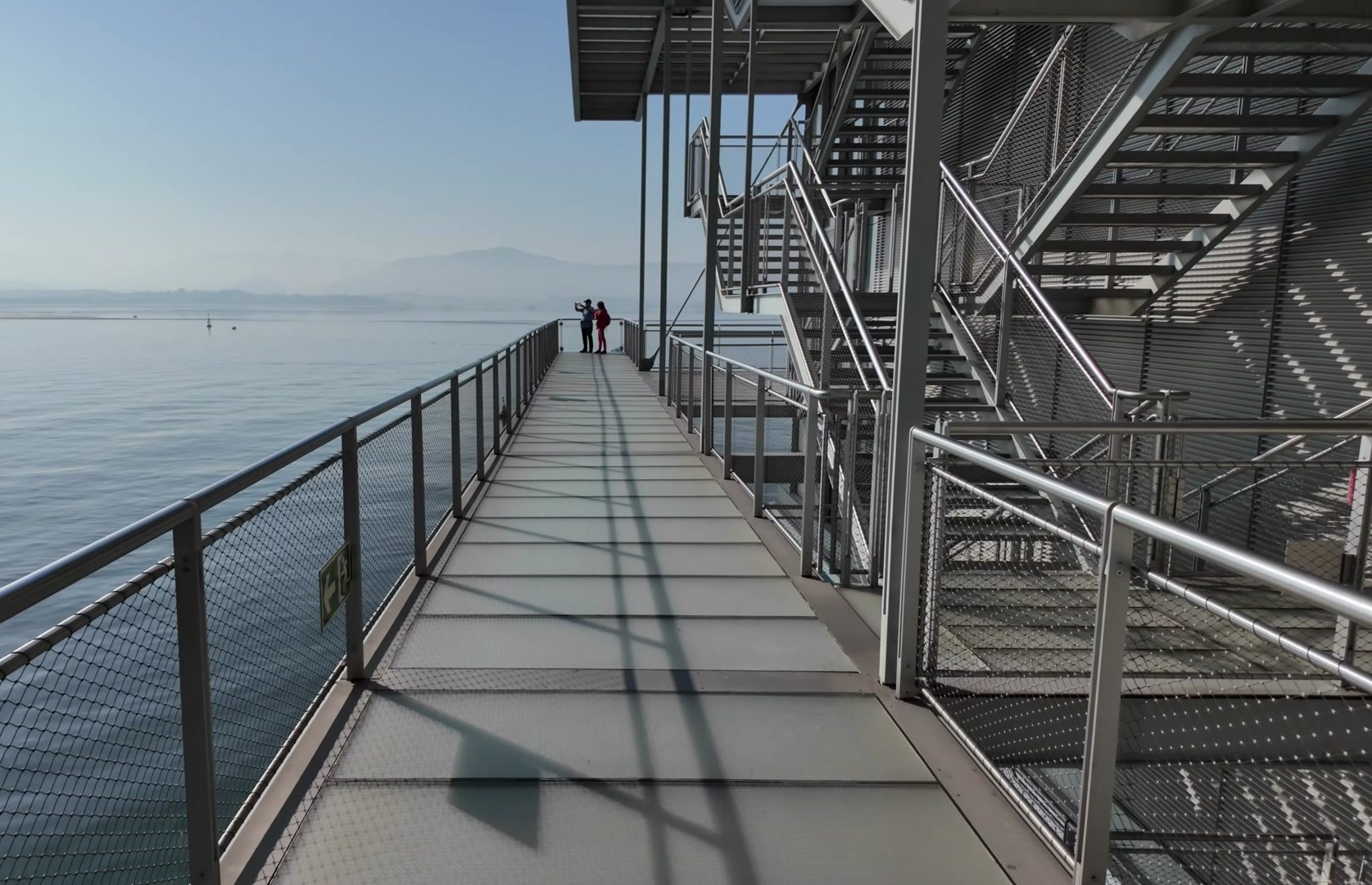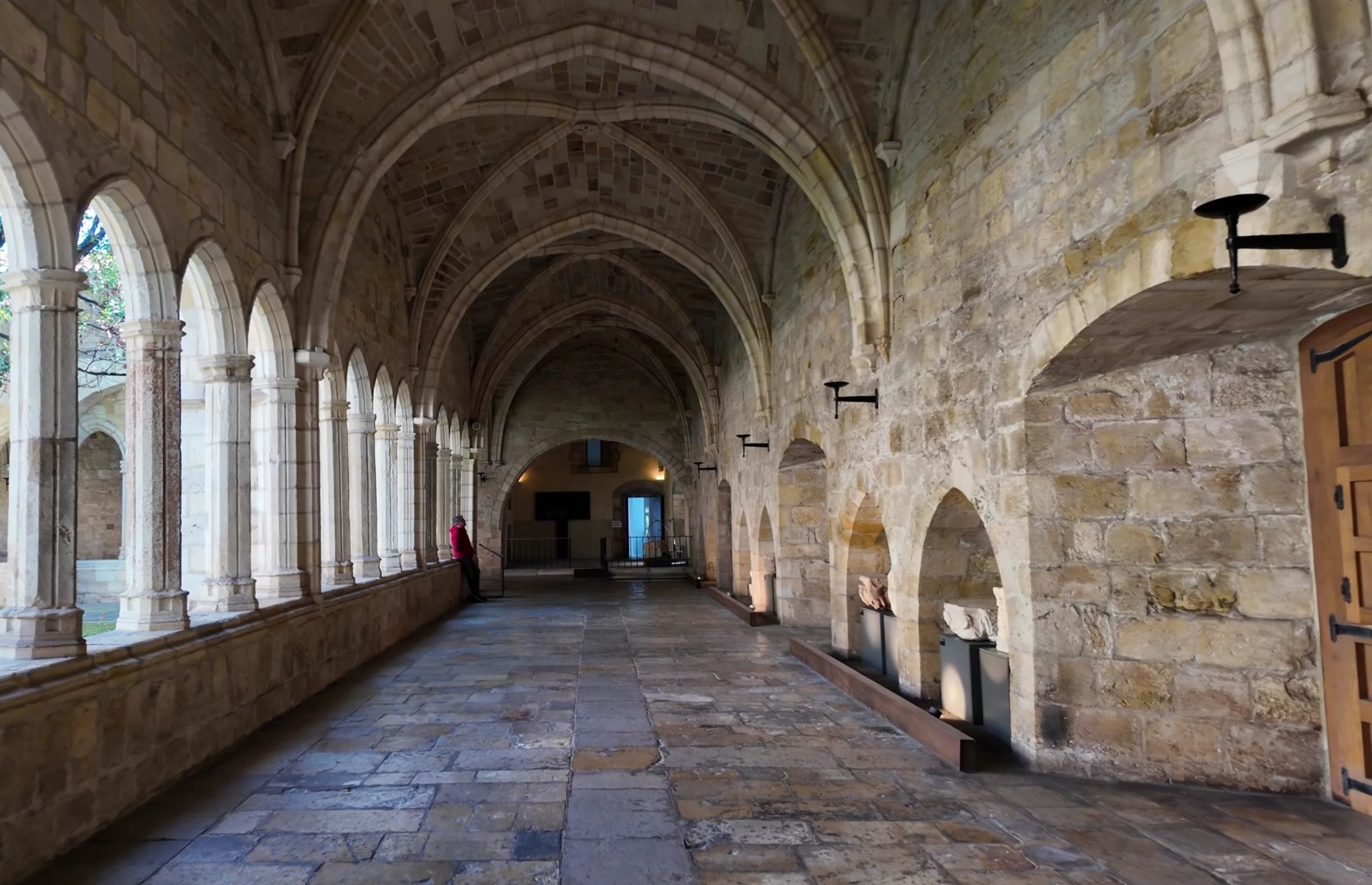
Hello friends. I want to talk about my visit to the city of Santander, the administrative capital of Cantabria. While Cantabria is not as large as other regions, it is an incredibly interesting place. We began our walk from the Santander Bay beach in the city center, right by the Botin Center. I chose this spot as it is the most fascinating landmark here, as it is a cultural and arts center designed by the renowned architect Renzo Piano and built at the request of the Botin Foundation. Botin was the CEO of Banco Santander, one of Spain's largest financial institutions and he started an art foundation, collecting art over time. Now, these artworks are exhibited in this amazing building.

The building consists of two main sections. One covers a large area of 2500 square meters and features various galleries. Different exhibitions are held here, displaying works from the Botin collection and works by invited artists. On the day we visited, portraits from the collection were being showcased. We paid an entrance fee of 5 euros. Although the collection is small, it features some notable names. One of the artists that stands out to me is Sorolla and a universally known name is Henri Matisse. And there is an exhibition by artist Sylvia Backley, offering an abstract watercolor work in a rather primitive style, but with a very interesting setup. The chairs in the exhibition are specially arranged to provide a comfortable space where visitors can sit and enjoy the art.







Another fascinating installation is titled Shelf Life, a name based on a wordplay. It refers both to the life of shelves and their expiration date. Sylvia and her partner have created a collage by combining broken pieces of old white furniture and Sylvia has crafted a highly expressive work. While the exhibitions may not be extraordinary, the building itself is striking.

The second section is somewhat smaller, covering 950 square meters and here, there is a conference hall, some classrooms and likely various events are held. For example, there are displays announcing a film festival held in Santander. The glass facades of both buildings open up to the bay on one side and to the gardens in front of the building on the other. These gardens were redesigned during the construction of the building. Right behind the gardens, the panoramic view of Santander can be seen.



We can see the city with a very modern appearance, as it was greatly affected by a large fire in 1941, which lasted two days and destroyed 37 streets and 14 hectares of land. As a result, although the city was founded in the 10th century, it does not look very old due to these events. The buildings we see are from the second half of the 20th century. This is why Renzo Piano's building blends well with the modern architecture. The building also harmonizes very well with the bay, as the reflection of the waves can be seen in both the interior and on the facade. The facade is very interestingly covered with ceramic discs.



Of course, Renzo Piano's signature is also visible here. The structural elements of the building wrap around the two sections, demonstrating that the building technique itself carries a certain poetry. After passing through the gardens, we reached the Mercado de (the market) area. This market is not one of the traditional markets we often see in Spain. It is housed in a historic building, which is quite impressive, with wooden beams, wooden columns and many protrusions.





If you're looking for a place to have dinner in the evening, I would recommend one of the restaurants listed in the Michelin Guide, which is also one of my favorite gourmet spots. The restaurant I visited here was fantastic. This restaurant holds the Bip Gourmand award, which is given when a three-course meal (starter, main course and dessert) or a starter, main course and a glass of wine is offered for up to 45 Euros. The prices at this restaurant exceed this standard. We paid 56 Euros, but it was definitely worth it. For instance, the salted shrimp we had was incredibly delicious. The tuna was superb and the fish croquettes were perfect. The hake fish, native to the Atlantic, was exceptional and these dishes were simply amazing.


Finally, we reached Velar Square. Here there is a place quite similar to the main square of Santander, known as Plaza Mayor. Of course, the official name of this square is Plaza de Velar, named after General Pedro Velar, who led the uprising against the Napoleonic invaders during the Iberian Peninsula Wars. Velar gave his life for his values. In this square, there is a statue in memory of this hero and interestingly, the statue is not facing the bay but another direction. It seems that this direction has a certain significance.



Just a few steps from the square is the Santander Cathedral, which is quite an interesting building. The cathedral is actually made up of two churches. The upper church has a simple decoration, but it is interesting. We paid an entrance fee of 2 Euros. Upon entering, we immediately went into the courtyard. Unlike most cathedrals where the courtyard is only accessible through galleries, here you can openly enter the courtyard. The second church is located one floor below, with a slightly lower ceiling and contains silver statues of Mithera and Sidonia, the patron saints of Santander. According to legend, these two saints were beheaded because they refused to renounce their Christian faith. Their heads were placed in a boat and sent into the oceans. Eventually the boat arrived in the Santander region, where the two saints were immortalized and honored. It is also said that the name Santander originated from the first saint's name, Sant Andrus. The reason the second saint's name was forgotten is unclear, but that is what the sources say.








By the way I really enjoy long coastal walks and when well-organized, they can be incredibly pleasant. Here while walking along the coast, it is possible to come across some fascinating things. One of the things I liked the most was the statue group of children diving. I am usually skeptical about city sculptures, but here everything is done in a very charming, dynamic and pleasant way. However, when we came to the Cantabria Festivals Palace, it was a very strange and quite massive building. It seems like a structure that doesn’t fit the context, as if it came from another place. It looks quite out of place among the modern structures of the 70s and 80s. But after that, everything becomes much more pleasant, as a lush green area starts here and some villas of the aristocracy are hidden among the greenery.




Next we visited the Magdalena Peninsula. Here we find the Royal Palace, Palacio de la Magdalena. This palace was built in a rather unusual style for Spain, almost like an English palace. As I mentioned, it was constructed at the beginning of the 20th century. There is an incredible park here, full of pine trees, lawns, rocky shores, lighthouses and modern art sculptures. It is an amazing place for a walk, offering a wonderful area to enjoy views of the ocean, the Bay of Biscay and Erne Beach.




This beach was actually like a promenade for aristocrats. It seems that the aristocracy also came here to rest, following the king. There was also an old casino in one of the buildings. I am not sure if it is still operational. I suppose, after such a beautiful place, I didn't want to explore further, because this place is really special and amazing.



So friends, if you ever find yourself in Santander, the Magdalena Peninsula is definitely a place you must visit. Everything else is optional, but in general I had a very pleasant impression of the city, despite the sometimes radical eclecticism in terms of architecture. Of course, Cantabria is also another great reason to visit here. Thanks for everything and see you on the next trip.
